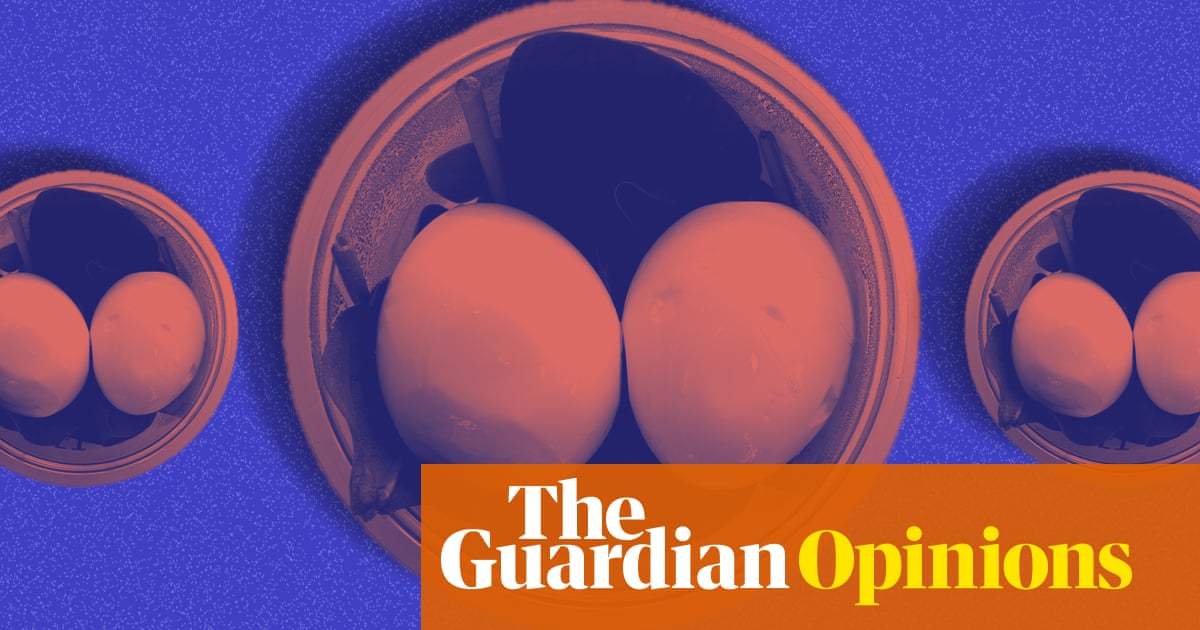Last year, I needed to eat on the go between exercising and an evening class. Frequently, I would find myself striding up a hill in the dark eating cold boiled eggs from a plastic pot. The eggs had been cooked into submission, with a grey ring around the chalky yolk that plastered itself across my tongue and teeth. The whites were rubbery, and the bottom of the pot held a little pool of mysterious cloudy water that made me shudder.
So why choose to eat the cursed eggs? I’m clearly not alone: Tesco recently revealed that boiled egg pots have ousted crisps from the top spot in its meal-deal league table (other retailers have reported equivalent growth in the snack’s popularity). It’s possible to read the “egg protein pot” as evidence of a joyless nation – a variation on the “joyless tubes”, the term the English writer Douglas Adams gave to sausages, bolstering his theory of a nation reluctant to eat anything pleasurable lest it felt like a sin.
Yet to me it seems more like the egg pot is symptomatic of the difficulty of deciding what to eat. We’re told that much of our food is bad for us, particularly when it’s “ultra-processed”. But this messaging can be confusing, and the language on food packaging is frequently inconsistent or even misleading. This translates into making decisions that bring us a sense of worthiness and little pleasure. I have subconsciously absorbed the presence of the protein bars and shakes racked up in my CrossFit gym, along with a vague idea that it’s important to eat them when you do such activities, even if you don’t have specific muscle-building intentions. So I eat the eggs, feeling virtuous but unsatisfied.
The egg-pot trend isn’t solely about consumers opting for cleaner or healthier choices, though. It’s specifically about a particular type of healthy eating, fuelled by an unprecedented cultural obsession with weight and body image. Rebranding eggs as a protein fix indicates how a wider culture of wellness shapes the products on our supermarket shelves. The fitness industry puts an unrelenting emphasis on specific types of weight loss, which means that we are less focused on how fitness can make us feel or what it can help us do, and instead inclined to think more about the “gains” that will result from it. Likewise, we have come to think of food as body fuel, rather than something to be enjoyed and shared. Food, like fitness, can become an instrumental pursuit.
At one time, it was only the rich and famous who hired personal trainers and nutritionists, joined elite gyms or optimised their eating and exercise routines. Fitness influencers have since democratised this, and you can now access tailored programmes and meal plans affordably online. In response, the food industry has developed products to fit this messaging. The egg pot was originally launched by Pret in 2015. That was the same year that ClassPass, a subscription service for high-end fitness classes, came to the UK. The previous year, the boutique spin studio Psycle opened in London, and LuluLemon, the designer gym-wear shop, launched its flagship UK store.
Many fitness influencers have migrated to offering nutrition advice, in which protein almost always plays a central role. Joe Wicks, who has become a kind of de-facto personal trainer to the nation, is as well known for his Lean in 15 recipes as for his workout videos. Earlier this month, I saw one of Wicks’s recipes circulating online: a cauliflower soup that was already high in protein, since it contained milk, cheese and blended chickpeas, which also called for 20g of protein powder. I have no idea what the soup tastes like, but I can certainly think of more delicious-sounding things to make.
It seems highly likely that if you are asking whether you’re getting enough protein, you are almost certainly meeting your protein requirements, and perhaps even exceeding them. Somewhere between stirring protein powder into cauliflower soup and eating dry, unseasoned chicken breasts from plastic containers, I worry that pleasure is being lost.
Don’t get me wrong; eating protein can be great. Whether it’s a golden-skinned roast chicken, soft steamed tofu drenched in a rich sesame sauce, or a dense bean salad, protein-rich foods fill us up and are (often) delicious. I am not even opposed to a boiled egg on the go; this is a popular snack in many countries, though usually in a less depressing form than in moist plastic packaging. But here’s the thing: carbohydrates are also delicious. A bowl of pasta, a baked potato, a plate of hot, salty chips – these are a good reminder that it’s time to let go of our carb-phobia and eat snacks that bring us joy.












